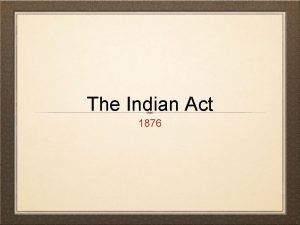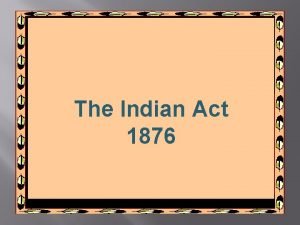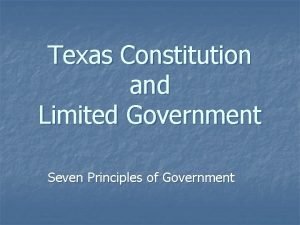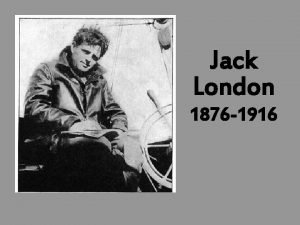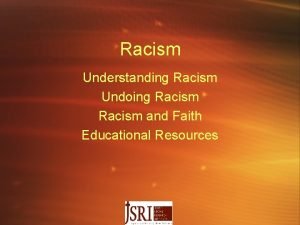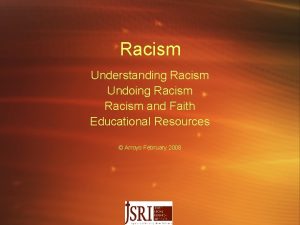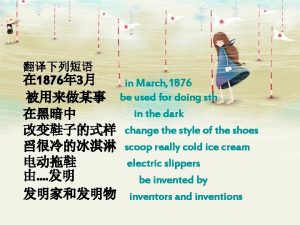Racism Continues 1876 1900 s Racism Continues My










- Slides: 10

Racism Continues: 1876 -1900 s

Racism Continues: My Q’s • What was Reconstruction and why did it end? • Why were racist Southern leaders called “Redeemers”? • What were Jim Crow laws? Provide examples. • Why was the Plessey v. Ferguson case important?

The Civil War & Reconstruction • In 1865, the North defeated the South in the Civil War, the bloodiest war ever fought in American history on American soil. • The most important result of the Civil War was that all African American slaves were given their freedom, given the right to vote, and given a semblance of equality. • This period after the Civil War is often called Reconstruction. • During Reconstruction, the American government literally attempted to “reconstruct” the war-torn South and also “reconstruct” the lives of slaves.

The Rise of Reconstruction • Early on during Reconstruction, the national government led by Republicans sent federal troops to the South to protect former slaves from angry masters. • The national government also created the Freedman’s Bureau, a government organization, to help blacks set up schools, find them jobs, and teach them how to read and write among other things. • Also early on during Reconstruction, all blacks were given full citizenship and the right to vote with the passing of the 14 th & 15 th Amendment.

The Fall of Reconstruction • The election of 1876 with Republican Rutherford B. Hayes—the three time governor of Ohio—running against Democrat Sam Tilden, ended up being the closest presidential election in American history. • The election results were so close in Oregon, South Carolina, Florida, and Louisiana that they had to recount all of the ballots in those states. • Hayes then struck a secret deal with racist Congressmen from the South: If they would make him president, he would end Reconstruction and pull the troops out of the South. • After the secret deal and the recount, Hayes ended up winning the election by one electoral vote, 185 -184.

Racism Returns • Keeping his promise, Hayes pulled the troops out of the South in 1877. • Without troops to protect former slaves, angry Confederate veterans, former masters, and Southern law-makers in the South legalized highly discriminatory laws against blacks called Jim Crow Laws. • This group of racist Southern leaders were called “Redeemers” because they wanted redemption for the Civil War and the Reconstruction period. Consequently, they took out their anger on African Americans in the South. • The Redeemers’ Jim Crow laws enforced racial segregation, banned biracial marriages, and severely restricted African Americans’ right to vote.

Food For Thought: Do you think racism is still a problem in the U. S?

Plessey v. Ferguson • One of the most important court cases of all time is Plessey v. Ferguson. • In 1890, the state of Louisiana made a law that required that passenger trains make separate cars for blacks and whites. • Therefore, a biracial man named Homer Plessey decided to test the law. He boarded a train car for white people only. • He did not know that a private detective was following his every move. As soon as Plessey boarded the train and took a seat he was arrested. • It became such a divisive court case that it made its way to the Supreme Court.

Plessey v. Ferguson Continued • The Supreme Court decided by a 7 -1 vote that racial segregation was constitutional, as long as the facilities were equal. • In other words, the Supreme Court decided that in any public space—museum, restrooms, schools—races could be kept separate as long as the public spaces were equal. • The only Supreme Court Justice to vote against the decision was John Marshall Harlan. He declared that “Our Constitution is color blind. ” • From that point on until 1954, most public facilities in the South were segregated and blacks were given much worse facilities to use.

The Rise of the Klan • In 1866, a group of seven Confederate war generals from Tennessee decided to form a social club called the Ku Klux Klan. They were known for their white hoods and secret rituals. • They quickly spread to every state and throughout the South. • They were known to commit horrendous crimes against former slaves, including raping grandmothers, burning down schools for children, and even roasting blacks over fires.
